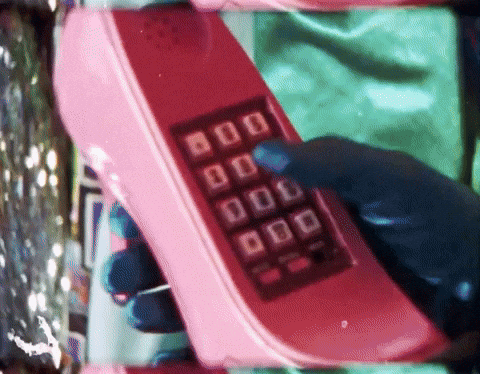🙅🏽♂️ YouTube is putting AI in a time-out
Plus: Tinder wants you to combine forces with your bestie, the controversial return of the corded phone, and McDonald’s minis.
Welcome back, Scanner!
What a month July has been! We have officially been marked safe from 10 days of the Calgary Stampede (which involved a surprising amount of horse-related shoots for our team) and (perhaps most importantly) the Love Island USA finale. It’s time to decompress with Bieber’s SWAG and some signals that are seriously standing on business. From Tinder’s new double date feature to the controversial return of the corded phone, some fascinating things are happening in our industry. So if it’s clocking to you, be sure to hit subscribe and start your scroll.
👇👇👇 This way!!
📅 CURRENT
Tinder Wants You to Swipe With Your Bestie
What’s changing?
Have you ever wished you could bring your friend along on a Tinder date? Now you can. Tinder has launched a new feature called “Double Date,” where you can invite a friend to find and match with another pair. Users in the U.S. will be able to invite up to three friends to create pairs with. You and your friend will be able to scroll through a special feed of paired profiles that appear side by side with photos and descriptions. You match when one person from both pairs swipes right. Then, Tinder will create a group chat with the four users. The new feature is intended to help Tinder engage more users as they experience a slump in performance.
Why does it matter?
We’ve discussed the importance of creating shared moments this year. This signal indicates that people want to move away from individualized, even transactional, interactions to something group-based. We’re seeing this mirrored across social platforms, with the rise of group chats, collaborative content creation, and friends features (like Notes, Collabs, Duets, Close Friends, location sharing, and more). People want real, genuine moments, and big brands are taking notice. Dating apps can feel like a numbers game, but with a friend, you know that (at least) you’ll create a lasting memory. Cleo Long, Tinder’s head of product marketing, told The Verge that this new feature attempts to relieve some of the pressure Gen Z experiences with dating by making it more social, fun, and comfortable.
What could happen next?
How we want to engage with and experience brands is shifting. There is this deep desire for social moments spent with friends. Will this encourage more social validation or confirmation tools for brands or on social media? Maybe we’ll see something like “verified by” badges where friends can verify that experiences or stories happened (particularly with the rise of AI)? What about a “collective likes” feature where groups can endorse posts? Or collaborative posting features (where users can’t post until everyone in the image or video has verified it)? As trends like “posting ennui” grow, changes to how we post (and with whom) might increase engagement for social media platforms. Plus, when friends need to verify or participate in posts, the pressure to fabricate perfect “Instagrammable” moments may decrease. Or, could we see more pressure to get into groups? Let us know what you think in the comments below!
Scan-o-meter: 📅 📅 📅 📅 📅 / 5
🎯 SPECIFIC
YouTube Is Cracking Down on Mass-Produced Content
What’s changing?
YouTube is saying “no thank you” to unoriginal, AI-created content (which includes mass-produced videos and other repetitive content). The platform has updated its policies to enforce monetization guidelines around authentic content. In the policy update, YouTube changes its language from not monetizing “repetitious content” to “inauthentic content,” enforcing rewards for creators that make original, authentic content. It’s an interesting move, particularly using the word “inauthentic” as digital audiences grow increasingly uneasy around AI-generated videos.
Why does it matter?
Quality and authenticity are winning over quantity these days. Flooding platforms with content isn’t the move anymore. Large platforms are clarifying that AI can be used as a tool, but it isn’t the strategy. Mass-produced, soulless content that relies on clickbait and spamming to get attention is not only being favored less by consumers, but social media platforms as well. It’s a good nudge for creators and marketers to make sure content is authentic, original, and interesting. AI can make the creation process more efficient, but at what cost? Though less efficient, realness may be the currency as AI technology becomes more pervasive.
What could happen next?
Other platforms may follow suit if YouTube successfully identifies and demotes mass-produced content. The “hack” of using AI to generate hundreds of variations of content will not only be ineffective, but potentially harmful to reach and engagement. Where could this lead? How about ‘artisanal content’ becoming a trend? Like how consumers pay premiums for handmade goods, we could see audiences and advertisers placing higher value on verified, human-created content. Will platforms race to see who can detect AI with the greatest accuracy? If AI continues to get more sophisticated, will any of this matter? Or will we pass a threshold where we can’t detect AI as easily, making it more enjoyable? We are living in this tension right now, a love/hate of this new technology, but AI is evolving, and we’ll likely need to marry the use of AI as a tool with our desire for humanness; creators and brands that find the “authenticity” sweet spot will be ahead of the game.
Scan-o-meter: 🎯🎯🎯🎯 / 5
😲 SURPRISING
The Corded Phone’s Controversial Return
What’s changing?
Styled after classic landline phones, the new “Tin Can” device allows kids to enjoy voice calling without the digital distractions, apps, and internet connectivity that smartphones bring. The phone only accepts calls from your chosen contacts (managed by a parents-only companion app). The Tin Can doesn’t support apps, texting, or games, but it uses WiFi and has minimal features like a Do Not Disturb mode. It is marketed as a response to ongoing parental worries: excessive screen time, digital predators, and the decline of in-person communication skills.
Why does it matter?
The outcry over how smartphones and devices are impacting our attention spans isn’t new, but it’s interesting to see how people and brands are trying to solve it. Devices like the Tin Can, or even the “Methaphone,” make us wonder if we’re looking for real solutions, or just creating more noise. There’s consistent movement away from endless connection to quality connection, but is it enough? The intention is there, with devices limiting use, but they ultimately still pull our attention toward device use. Can devices like the Tin Can answer the call for meaningful experiences? Or are they a band-aid solution for scared parents with significant purchasing power and influence? Could we better connect with these parents, listening to their fears instead of feeding into them?
What could happen next?
If the fight against “addictive” tech accelerates, we may see significant changes in both the frequency and nature of how people interact with phones, social media, and apps, creating new challenges for brands and marketers who rely on these to connect. As brands and content creators, how can we ensure we’re investing in areas that work where online access is reduced or changed? Could it be through audio content, email newsletters, or physical work? Could blocking (by choice or via restriction) apps on devices push digital audiences toward branded media channels and direct-to-consumer strategies? How could this signal change the products people want? We talked in a previous issue about how people are moving away from high-tech homes – in a way, this signal continues this idea that “simplicity as a feature” is being sold, suggesting we are moving toward “technological restraint” as a selling point. But when it comes down to it, do we really want simpler tech? Or do we just want… New tech to play with?
Scan-o-meter: 😲😲😲😲/ 5
🔍 TREND REPORT IRL
Updates from our Trend Forecast
We recently shared our second Trend Report with you! As the year goes on, we’ll continue investigating signals that further the conversation around our two forecasts. Here’s what we’re watching this week:
People want realness: Ditch the foundation. People are going makeup free on first dates.
People want shared moments: Our new fav show? Overheard at Wimbledon (Episode 1, Episode 2, Episode 3, Episode 4)
People want to play: Dibs on the Halloween bucket! McDonald’s finally hops on the minis trend.
Want more trend news? Check out What (Digital) Audiences Want In 2025!
🤔 BEFORE YOU GO
To help keep these signals top-of-mind, we share 1 question to ask yourself (or your team) in each edition. Your question to ponder this week is:
See you next time 👋







